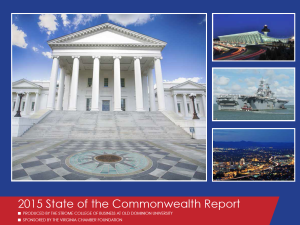This is the 1st State of the Commonwealth Report. It is jointly sponsored by the Strome College of Business at Old Dominion University and the Virginia Chamber Foundation. While the report represents the work of many people connected in various ways to the university, it does not constitute an of cial viewpoint of Old Dominion or its president, John R. Broderick. Similarly, it does not represent the views of the Virginia Chamber of Commerce or its president and CEO, Barry DuVal.
The goal of the report is to stimulate thought and discussion that ultimately will make Virginia an even better place to live, work and do business. We are proud of the Commonwealth’s many successes, but realize that it is possible to improve our performance. In order to do so, we must have accurate information about “where we are” and a sound understanding of the policy options open to us.
The 2015 report is divided into eight parts:
The Virginia Economy Struggles to Cope with Economic Headwinds: The Virginia economy grew 0.02 percent in real terms in 2014, will grow only about 1.33 percent in 2015, and we forecast only a 1.98 percent growth rate in 2016. The villain in this scenario is stagnant or declining federal spending, especially defense spending.
Northern Virginia: Standing at a Fork in the Road? Direct federal employment and procurement spending accounts for almost 40 percent of all economic activity in Northern Virginia, which in turn accounts for more than 40 percent of all economic activity in Virginia. Sequestration has hobbled Northern Virginia’s growth. However, George Mason University’s leading economic index suggests better times are on the horizon.
Digging Deeper: A Closer Look at Defense Spending in Virginia: An estimated 11.8 percent of Virginia’s GDP depends upon defense spending. An important part of this are the contracts awarded to Virginia businesses by the Department of Defense. Two regions – Northern Virginia and Hampton Roads – account for 86 percent of these contracts.
If You Can Make It There . . . You Can Make It Even Better in Virginia: The good news is that the “real,” in ation-adjusted incomes of Virginians in nearly every area of the Commonwealth are higher than in nearly all comparable regions along the Atlantic Coast, including New York City.
Fly Away With Me: A Look at Virginia’s Airports: For several years, both passenger traf c and the number of available seats have been in decline at nearly all of the Commonwealth’s airports. Reagan/Washington National and Charlottesville are the major exceptions. Decisions made by the U.S. Congress have placed a particular burden on Dulles International.
The Small-Business Story in Virginia: What a Quarter Century of Data Reveal: Very small businesses in Virginia (those with fewer than 10 employees) have been holding their own, but many have found it dif cult to grow beyond this size. Very small businesses now account for smaller proportions of total employment and payrolls in Virginia than was true 25 years ago. However, public policy changes can alter this situation.
Consolidating or Merging the Public Service Provision in Virginia Cities and Counties: Where Can We Save the Most Money? Controlling for variables such as the cost of living and local characteristics, we examine the provision of 25 distinct public services by the 95 counties and 39 independent cities in Virginia. Could we save money and perhaps provide better services if we combined the provision of some of these services across county and city lines? The evidence suggests that the answer is yes for at least 13 of these public services and perhaps for another four.
Domestic Migration: What Moves Us? Virginians and all other Americans can vote with their feet and move from one location to another in response to job opportunities, amenities and other factors. Recently, Virginia has experienced very low or even negative levels of net domestic migration. We look at the migration experience of 358 metropolitan regions nationally (including the largest eight in Virginia) to provide some answers.
